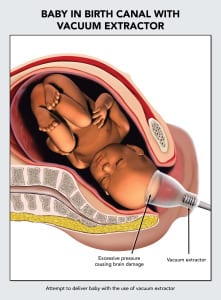About Vacuum Extraction Delivery

Vacuum extraction (ventouse) is used during childbirth for difficult or prolonged deliveries. During the process, a suction cup is placed on the baby’s head to help them move through the birth canal.
The procedure is usually performed in the second stage of labor to lower risks for both the mother and child. Some delivery teams choose this option to avoid a cesarean section (C-section), which requires surgery.
Delivery teams may perform vacuum extraction for these reasons:
- Concerning heart rate in the baby
- Health conditions or exhaustion preventing the mother from pushing
- The second stage of labor is taking too long
Vacuum extraction is generally a safe and effective option. However, if the tool is used improperly or things go wrong, vacuum extraction complications can cause serious health problems.
If you or your child were harmed because of vacuum extraction, you might qualify for financial assistance through a birth injury lawsuit.
Get a free case review now to find out if the Birth Injury Justice Center can help you.
Vacuum Extraction Complications Warning Signs in Newborns
Vacuum extraction complications warning signs can show up in different ways in a baby. Spotting these signs early is important for addressing any potential health issues.
Some warning signs of vacuum extraction complications are listed below.
Jaundice
If they are not properly addressed, vacuum extraction complications warning signs can lead to newborn jaundice. This condition causes a yellow tint to the baby’s skin and the white part of the eyes.
Jaundice is a sign of excess bilirubin, a liver product from hemoglobin (protein in red blood cells that carries oxygen) that is excreted in bile.
Newborn Hearing Issues
If a baby develops newborn jaundice as a result of vacuum extraction, they may experience hearing issues. This is because the auditory nervous system is highly sensitive to bilirubin levels.
Scalp Bleeding or Bruising
When delivery teams apply too much suction, they can cause a scalp injury or lacerations.
Your baby may develop cephalohematoma (a buildup of blood under the scalp) if there were complications during a vacuum extraction delivery. Cephalohematoma is usually harmless.
Scalp Swelling
Too much suction from the soft cup can make the baby’s scalp swell, causing a condition called caput succedaneum. Swelling usually resolves on its own, but it can lead to temporary hair loss and jaundice.
Shoulder Dystocia
Shoulder dystocia occurs when a baby’s shoulders are stuck in the vaginal canal. Vacuum extraction can lead to shoulder dystocia if a baby’s head, arm, shoulder, or neck is pulled by the machine while still in the birth canal.
Shoulder dystocia occurs more often in vacuum extraction than vaginal delivery or when a baby is delivered using forceps. This may be because vacuum extraction is often used for larger babies (fetal macrosomia) already at increased risk of shoulder dystocia.
Skull Fractures
Vacuum extraction can injure the delicate skulls of babies. Most newborn skull fractures are small, cause no long-term damage, and heal on their own.
Unfortunately, more severe fractures can cause brain bleeding (intracranial hemorrhage) and may require surgery.
Skull fractures can result from excessive force during birth, including vacuum extraction or forceps use, and are considered one of the vacuum extraction complications warning signs.
You probably have questions if you think your baby was harmed after your obstetrician or delivery team failed to spot or manage the warning signs of vacuum extraction complications.
Our registered nurses can help talk you through what might have occurred. Connect with one of our labor and delivery nurses right now in confidence.
Maternal Vacuum Extraction Complications Warning Signs
Vacuum extraction can also cause various complications in the mother.
Some common maternal vacuum extraction complications warning signs are listed below.
Broken Tailbone
A broken tailbone is a warning sign of vacuum extraction complications.
Symptoms of a broken tailbone include:
- Constant dull pain in the low back
- Irregular bowel movements
- Pain that intensifies during a bowel movement or sexual intercourse
- Swelling around the tailbone
Excessive Postpartum Bleeding
The suction cup pressure and maternal contractions can cause vaginal and perineal tears (the area between the vagina and the anus), leading to excessive bleeding or postpartum hemorrhage (PPH).
Excessive postpartum bleeding (or PPH) is significantly higher in vacuum deliveries than in unassisted vaginal births, according to a 2021 Cureus, Journal of Medical Science report.
PPH is very dangerous, leading to severe blood loss, low blood pressure, shock, and even death.
Pelvic Pain
The vacuum cup and pump can cause tears in the perineum, leading to pelvic pain. Pelvic pain can make sitting and moving difficult.
Pelvic pain is also common after childbirth, but especially in women whose deliveries or labors were difficult.
Trouble Urinating
The suction force during vacuum-assisted deliveries can cause significant stretching of the vaginal area. Consequently, mothers might experience problems with bladder emptying and short- or long-term urinary incontinence.
If you’ve faced urinary incontinence following a complicated delivery, vacuum extraction could be the cause. Talk with your doctor if you have concerns.
Vaginal Tearing
Vaginal tearing, a warning sign of vacuum extraction complications, refers to the tearing of vaginal tissue during childbirth. It can result from excessive force during delivery, potentially causing pain and additional complications.
There are four grades of vaginal tears:
- First-degree tears are the least severe. They only involve the first layer of skin around the vaginal and perineal areas and usually don’t require stitches.
- Second-degree tears are the most common. They extend deeper into the underlying muscles of the vagina and perineum and usually require stitches.
- Third-degree tears extend from the vagina to the anus. They affect the skin and muscles of the perineum and the anal sphincter muscles. Women need stitches if they have third-degree tears.
- Fourth-degree tears are the least common. They extend from the vagina to the perineal area and rectum. Women with these injuries may need surgical treatment.
Medical Negligence and Vacuum Extraction Complications
Complications from vacuum-assisted vaginal delivery are sometimes unavoidable. However, they can also result from medical negligence.
Medical negligence occurs when health care professionals do not uphold the standard of care. This can happen by either failing to do something medically necessary or doing something wrong, resulting in harm or death.
Obstetricians may be considered negligent if they:
- Did not perform a C-section when one was needed
- Did not prepare for vacuum extraction properly, such as neglecting to dilate the cervix, causing ruptured membranes
- Failed to adequately inform about the risks and potential for vacuum extraction complications before using the device
- Failed to identify and prevent complications from vacuum extraction, potentially leading to brain damage, lifelong disabilities, or even death
- Failed to monitor the mother and baby’s health
- Failed to perform necessary procedures like using an epidural when needed
- Improperly used assisted delivery devices, like opting for unnecessary vacuum extraction, forceps delivery, or operative vaginal delivery
- Neglected the health of the mother and baby while performing a vacuum pump extraction delivery
If you suspect that your delivery team failed to spot and manage vacuum extraction complications warning signs, you may have legal rights.
Find out now with a free case review.
Causes of Vacuum Extraction Delivery Complications
The main cause of vacuum extraction complications is an improperly performed assisted delivery.
Medical professionals should only perform vacuum extraction if needed — babies and mothers are more likely to be injured with a vacuum delivery than by natural birth.
Certain factors can heighten the risk of injuries from vacuum extraction, including:
- Baby’s head hasn’t moved past the middle of the vaginal canal
- Bone or bleeding disorder in the baby
- Doctor can’t determine the position of the baby’s head
- Mother’s pelvis is too small for the size of the baby
- Preterm baby
Delivery teams should not use a vacuum extractor if any of these risk factors apply.
Long-Term Effects of Birth Injuries Caused by Vacuum Extraction
Babies can suffer lifelong harm when delivery teams fail to detect and manage the warning signs of vacuum extraction complications.
Severe vacuum extraction birth injuries can lead to long-term conditions, such as:
- Cerebral palsy: A group of disorders affecting a person’s ability to maintain posture and move. It may occur with or without intellectual disability.
- Erb’s palsy: A type of arm paralysis caused by injury to the upper group of the main nerves supplying the arm and shoulder (the upper trunk of the brachial plexus). It is a type of brachial plexus injury.
- Kernicterus: A type of brain damage occurring when medical professionals fail to treat newborn jaundice in a timely manner, potentially leading to athetoid cerebral palsy (CP).
If you think your baby was harmed, making a plan without delay is essential.
Next Steps for Vacuum Extraction Complications
Dealing with vacuum extraction complications can cause your family an unexpected disruption in life. In severe cases, they can lead to life-altering conditions for your baby, such as brain damage.
Consider taking the following steps if you and your baby have experienced vacuum extraction complications.
1. Seek Treatment Right Away
Promptly seek medical attention if your baby is injured. A medical team will conduct tests and examinations to identify the cause of your baby’s injuries, ensuring a proper diagnosis.
For children with long-term birth injuries such as CP, their growing needs may include physical therapy, speech therapy, and mobility aids like wheelchairs. Your health care provider will guide you to the relevant specialists.
2. Consult a Birth Injury Lawyer
Following treatment and diagnosis, consider consulting with a lawyer. A skilled birth injury attorney will review your case to determine if you can file a birth injury lawsuit to hold negligent medical providers accountable.
3. File a Birth Injury Lawsuit
If you are eligible to file a birth injury lawsuit, your lawyer can gather evidence, negotiate a settlement, and fight for your rights at trial if needed.
Successful birth injury lawsuits provide compensation for various losses, such as medical expenses, lost income, pain and suffering, and diminished quality of life.
Get Legal Help for Vacuum Extraction Complications
Detecting and responding to the warning signs of vacuum extraction complications is an essential part of your delivery team’s duty of care. If a health care professional overlooked these signs during your vacuum extraction, you may have a birth injury medical malpractice case.
The Birth Injury Justice Center can connect you with an experienced birth injury law firm if you are eligible.
Our legal partners have helped families secure over $862 million for preventable birth injuries. Find out if they can help your family as well. Get a free birth injury case review right now.
Vacuum Extraction Complications Warning Signs FAQs
What are the potential complications of vacuum extraction?
Vacuum extraction complications include:
- Hearing issues
- Jaundice
- Scalp bleeding
- Scalp swelling
- Shoulder dystocia
- Skull fractures
What is the most serious complication of vacuum extraction?
Some of the most severe vacuum extraction complications include:
- Kernicterus (severe brain damage often caused by untreated jaundice)
- Skull fractures
- Subgaleal hemorrhage (bleeding between the skull and scalp)
These conditions can cause brain damage, which can lead to intellectual disability, cerebral palsy, and even death.
Can you sue for complications of vacuum extraction deliveries?
Yes, if your medical provider failed to meet the standard of care and you or your child suffered severe harm, you may be able to file a medical negligence lawsuit.
Birth injury lawsuits can result in financial compensation that can be used to provide the best care possible for your child.
Get a free case review right now to learn more about your legal options.




